In recent years, the adoption of vertical farming system has grown steadily among agricultural professionals seeking efficient and sustainable cultivation methods. Unlike traditional farming, these systems utilize controlled environments to optimize growth conditions, allowing for consistent yields regardless of external climate or soil conditions. By integrating advanced technologies, growers can achieve higher productivity while maintaining quality standards that meet the demands of sophisticated markets in Europe, North America, the Middle East, and Asia-Pacific regions. Moreover, these systems offer the ability to plan production cycles more precisely, helping businesses align harvest times with market demand and seasonal fluctuations.
Enhancing Growth Efficiency with Integrated Systems
One significant advantage of a vertical farming system is its ability to maximize space utilization through vertical stacking of plant trays. This approach enables multiple crop cycles within a year, significantly reducing the time between harvests compared to conventional agriculture. Companies like 4D Bios have developed solutions such as the Containerized Grow System, a mobile planting platform designed to provide optimal lighting, nutrient delivery, and climate control. By overcoming environmental limitations, this system ensures plants receive ideal growth conditions, supporting consistent development for a wide variety of crops. Additionally, integrated systems reduce the need for large outdoor plots, which is particularly advantageous in urban or land-constrained areas, allowing experienced growers to produce higher quantities of vegetables or specialty plants without requiring additional farmland.
Environmental and Resource Advantages
Beyond productivity, vertical farming system technologies contribute to sustainable practices by reducing water usage and limiting the need for chemical inputs. Controlled nutrient delivery and efficient irrigation systems allow growers to minimize resource waste, while enclosed environments help prevent pest infestations without relying heavily on pesticides. These benefits are particularly appealing in regions facing water scarcity or stringent agricultural regulations, such as parts of the Middle East and Australia. Furthermore, controlled lighting and environmental management allow for year-round production, which aligns with local market needs and supports a steady supply chain for commercial operations. Such consistent output can help businesses meet contract obligations or supply high-end retail markets with fresh produce throughout the year, strengthening their reliability and reputation.
Conclusion: Strategic Value for Experienced Growers
Adopting a vertical farming system provides experienced growers with a practical method to optimize yield, ensure consistent quality, and implement sustainable practices. The combination of vertical cultivation techniques, intelligent lighting, automated nutrient systems, and precise environmental control delivers measurable advantages for commercial operations. Companies like 4D Bios continue to expand the accessibility of these solutions, offering integrated plant factory systems suitable for diverse markets. By leveraging controlled environment agriculture, professional growers can respond more effectively to market demands, reduce operational risks caused by weather or pests, and improve overall resource efficiency, making this approach an increasingly valuable option for those looking to modernize agricultural production.

